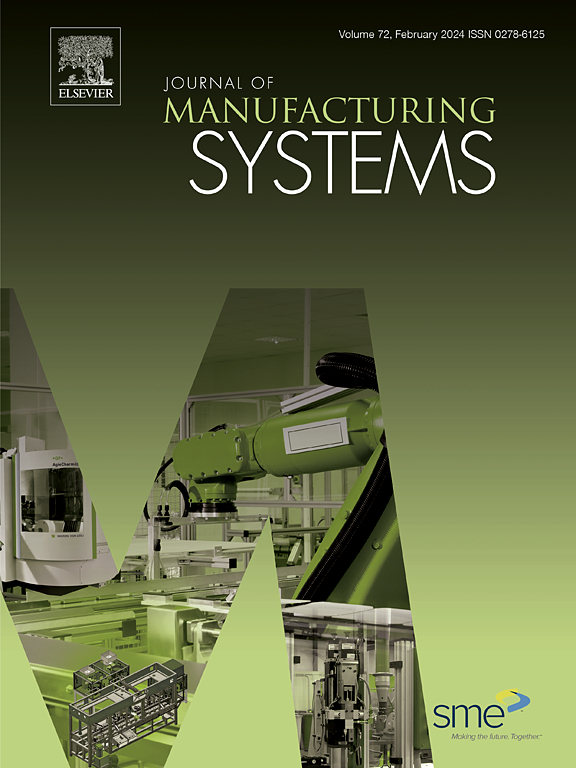A comparative life cycle assessment of kraft lignin and hemp straw fillers to improve ductility of polylactide (PLA) 3D printed parts
IF 14.2
1区 工程技术
Q1 ENGINEERING, INDUSTRIAL
引用次数: 0
Abstract
This research is motivated by the increasing demand for bio-based materials, the recent growth of the U.S. hemp industry, and the broader trend of using sustainable filaments in additive manufacturing. This study presents a comparative life cycle assessment (LCA) of untreated hemp straw and kraft lignin as fillers for polylactic acid (PLA) 3D-printed tensile specimens to evaluate their environmental impacts. Both materials, being low-cost renewable bio-based fillers, can enhance elongation of PLA while reducing the environmental footprint of 3D-printed components. The environmental impacts of hemp straw-PLA and kraft lignin-PLA were assessed using several life cycle impact assessment (LCIA) methods, including ReCiPe 2016 Endpoint (H), Cumulative Energy Demand (CED), and IPCC GWP100. Hemp straw showed lower environmental impacts than kraft lignin across most categories, making it a more favorable option for eco-conscious prosumers. The ReCiPe 2016 results indicated that major impact categories for kraft lignin-PLA were fine particulate matter formation, global warming potential, and human toxicity, with filament production being the major contributor. For hemp straw-PLA, hemp straw pre-processing was the major contributor. The CED method revealed that nonrenewable fossil resources had the highest impact on both materials. IPCC GWP100 results aligned with CED, showing higher greenhouse gas emissions for kraft lignin-PLA, mainly due to fossil fuel use. Sensitivity analysis of transportation distances showed no significant differences in impact results, while alternative LCIA methods (TRACI and IMPACT World+) confirmed the consistency of the findings. To build upon this study, future work will explore the environmental performance of treated hemp materials as alternative fillers for 3D-printed components.
牛皮木质素和大麻秸秆填料提高聚乳酸(PLA) 3D打印部件延展性的生命周期比较评估
这项研究的动机是对生物基材料的需求不断增长,美国大麻产业的近期增长,以及在增材制造中使用可持续长丝的更广泛趋势。本研究提出了未经处理的大麻秸秆和硫酸盐木质素作为填料的生命周期比较评估(LCA),用于聚乳酸(PLA) 3d打印拉伸试样,以评估其环境影响。这两种材料都是低成本的可再生生物基填料,可以提高PLA的伸长率,同时减少3d打印部件的环境足迹。采用ReCiPe 2016 Endpoint (H)、Cumulative Energy Demand (CED)和IPCC GWP100等多种生命周期影响评估(LCIA)方法,对大麻秸秆- pla和牛皮木质素- pla的环境影响进行了评估。在大多数类别中,大麻秸秆对环境的影响比牛皮木质素低,使其成为具有生态意识的消费者更有利的选择。ReCiPe 2016的结果表明,硫酸盐木质素- pla的主要影响类别是细颗粒物形成、全球变暖潜势和人体毒性,其中长丝生产是主要影响因素。对于大麻秸秆- pla,大麻秸秆预处理是主要贡献者。CED方法显示,不可再生的化石资源对这两种材料的影响最大。IPCC GWP100的结果与CED一致,表明硫酸盐木质素-聚乳酸的温室气体排放量更高,主要是由于化石燃料的使用。交通距离的敏感性分析显示影响结果没有显著差异,而替代的LCIA方法(TRACI和impact World+)证实了结果的一致性。为了在这项研究的基础上,未来的工作将探索处理过的大麻材料作为3d打印部件的替代填料的环境性能。
本文章由计算机程序翻译,如有差异,请以英文原文为准。
求助全文
约1分钟内获得全文
求助全文
来源期刊

Journal of Manufacturing Systems
工程技术-工程:工业
CiteScore
23.30
自引率
13.20%
发文量
216
审稿时长
25 days
期刊介绍:
The Journal of Manufacturing Systems is dedicated to showcasing cutting-edge fundamental and applied research in manufacturing at the systems level. Encompassing products, equipment, people, information, control, and support functions, manufacturing systems play a pivotal role in the economical and competitive development, production, delivery, and total lifecycle of products, meeting market and societal needs.
With a commitment to publishing archival scholarly literature, the journal strives to advance the state of the art in manufacturing systems and foster innovation in crafting efficient, robust, and sustainable manufacturing systems. The focus extends from equipment-level considerations to the broader scope of the extended enterprise. The Journal welcomes research addressing challenges across various scales, including nano, micro, and macro-scale manufacturing, and spanning diverse sectors such as aerospace, automotive, energy, and medical device manufacturing.
 求助内容:
求助内容: 应助结果提醒方式:
应助结果提醒方式:


